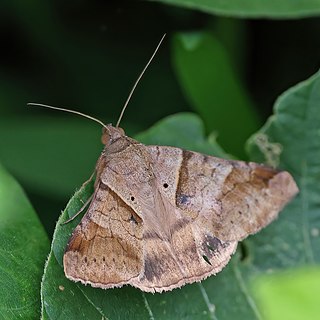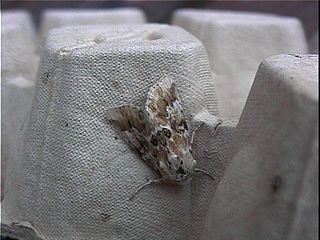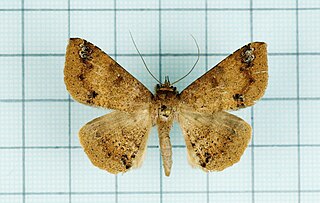Related Research Articles

Mocis undata, the brown-striped semilooper, is a moth of the family Erebidae. The species was first described by Johan Christian Fabricius in 1775. It is found in the Afrotropical and Oriental regions, including India and Sri Lanka.

Eremobia ochroleuca, the dusky sallow, is a moth of the family Noctuidae. It is found in Central and Southern Europe and the Middle East.
Mythimna irrorata is a moth of the family Noctuidae first described by Frederic Moore in 1881. It is found in the north-western parts of the Himalayas and Sri Lanka.

Nycteola revayana, the oak nycteoline, is a moth of the family Nolidae. The species was first described by Giovanni Antonio Scopoli in 1772. It is found from Europe and east across the Palearctic to Japan and India.
Mothonica is a genus of moths in the family Depressariidae.

Ericeia inangulata, the sober tabby, is a moth in the family Erebidae. The species was first described by Achille Guenée in 1852. It is found in the Indo-Australian tropics of China, India, Sri Lanka, Myanmar, and the Marianas and Carolines, Fiji, Vanuatu, New Caledonia and Samoa.
Compsolechia dicax is a moth of the family Gelechiidae. It was described by Edward Meyrick in 1914. It is found in Guyana and Peru.
Anacampsis tephriasella is a moth of the family Gelechiidae. It was described by Vactor Tousey Chambers in 1872. It is found in North America, where it has been recorded from Illinois, Kentucky and Maine.

The Stenomatinae are a subfamily of small moths in the family Depressariidae.
Autosticha relaxata is a moth in the family Autostichidae. It was described by Edward Meyrick in 1916. It is found in Sri Lanka.
Lethata monopa is a moth of the family Depressariidae. It is found in Rio de Janeiro, Brazil.
Antaeotricha carbasea is a moth of the family Depressariidae. It is found in Brazil.
Lethata psidii is a moth of the family Depressariidae. It is found in the Guianas and Venezuela.
Stenoma thoristes is a moth of the family Depressariidae. It is found in French Guiana.
Synchalara minax is a moth in the family Xyloryctidae. It was described by Edward Meyrick in 1907. It is found in India (Assam).
Menestomorpha is a moth genus of the family Depressariidae.
Antaeotricha fuscorectangulata is a moth in the family Depressariidae. It was described by W. Donald Duckworth in 1964. It is found in North America, where it has been recorded from Arizona.
Lethata fusca is a moth in the family Depressariidae. It was described by W. Donald Duckworth in 1964. It is found in Amazonas, Brazil.
Lethata leucothea is a moth in the family Depressariidae. It was described by August Busck in 1914. It is found in Panama.
Chlamydastis chlorosticta is a moth in the family Depressariidae. It was described by Edward Meyrick in 1913. It is found in Peru, the Guianas and Brazil.
References
- ↑ Savela, Markku. "Menestomorpha kimballi (Duckworth, 1964)". Lepidoptera and Some Other Life Forms. Retrieved January 3, 2018..
- ↑ Moth Photographers Group. Mississippi State University.
- ↑ Proceedings of the United States National Museum 116 (3495): 47
 This article incorporates text from this source, which is in the public domain .
This article incorporates text from this source, which is in the public domain .